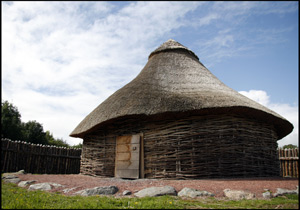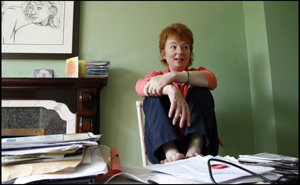By Meg Carey Her hair was a fiery crimson that flowed down to the small of her back, and she gathered her green robes lightly in her right hand to aid her as she waddled down the hill. Her belly gyrated with the movement of tiny limbs. Two hearts were beating under her own. With furrowed brow, the Celtic goddess Macha made her way to the court to race King Conchobor's chariot and ultimately to save her husband's life.
 Macha was an ancient goddess, a key figure in the Ulster Cycle, a series of pre-Christian tales that have deep historical significance for Armagh. These tales are the spiritual account of the early Celtic people of Ulster and tell of legendary warrior heroes and heroines who fought great battles against Queen Maeve and the warriors of Connaught.
The high kings of Ireland established the first royal capital of Ulster at Emain Macha ("Twins of Macha"), the historical site now occupied by the earthworks at Navan Fort. [hyperlink to Cate's site on Navan Fort] Emain Macha has remains from over 7,500 years ago and lies on the outskirts of the city of Armagh. The goddess Macha played an important role in the spiritual birth of this capital of Ulster. It is said that Macha gave birth to twins who brought both a blessing and a curse to the northern Kings of Ireland. Yet there is some ambiguity as to which of several "Machas" referred to in legend actually corresponds to the city Armagh.
 The term from which "Armagh" is thought to derive is Ard Macha in Gaelic, which means " the height" or "the hill of Macha." In several legends, Macha was an Irish goddess who has sometimes been seen as one or as many as three deities. She is also connected to two other goddesses: the Morrigan and the Badbh. This group of three is traditionally linked with war, fertility, and the prosperity of Ireland.
There are various Irish legends about Macha, three of which are considered most important. The first recounts the story of a woman named Macha who was married to the leader of Clanna Nemid, Nemedh ("the sacred one"). Macha predicts the great destruction brought about by the Tain Bo Cuailnge , (a significant invasion of Ulster fought at Emain Macha). She was said to have died on one of the plains cleared by her husband and the site was named for her. The second Macha was a famed warrior ruler of Ireland who demanded the building of Emain Macha, the seat of the royal court and the capital of the province of Ulster.
The third Macha is the most fascinating. This legend consists of a woman of unknown origin, most likely divine, who marries a widower, Crunniuc. She is a skilled runner, and her husband brags to the king, Conchobor, that she can outrun his horses.
Irritated by his boasting, the king forces Macha to race his horses, even though she is very pregnant, close to giving birth. She pleads for a postponement of the bet, but the king will not concede. She races and ends up outrunning the king's horses.
This victory is immediately followed by the birth of her twins, and her death soon follows. Before she dies, however, she puts a blessing and a curse on the Ulster men, each symbolized by a twin.
The blessing is that Ulster's warriors would be bestowed with great strength and power. However, the curse is that in their time of greatest crisis, the Ulstermen would be struck down and become as weak and incapacitated as a woman in childbirth. The people, in an effort to alleviate the curse and appease Macha's spirit, named the site Emain Macha ("twins of Macha").
This curse comes to fruition many years later when the greedy warrior queen of the West, Maeve, attacks Emain Macha in an attempt to steal Ulster's most prized possession - the Brown Bull of Cooley. She attacks, and all of Ulster's warriors, except one man, are unable to fight because of the curse. The only man exempt from the curse is Cuchullain and with great effort he is able to defeat Queen Maeve and her entire army. Today, this legend is told throughout Ireland, but especially in Armagh. Sarah Black and Matthew Avenell, both employees of the Navan Fort Centre, remember hearing it in grade school. According to Glenda Reid, who also works at the Navan Fort Centre, the Ulster Cycle legends are valuable because they "represent our history...even though it's mostly myth." Reid credits the Ulster cycle tales with "empowering women" because of the strong female goddess figures highlighted throughout the legends.
Emain Macha has become an incredible archeological conservation site. Ancient burial and ritual sacrifice sites have been discovered in and around the fort. One fascinating discovery was the skull and jawbone of a Barbary ape, which implies the presence of a royal or otherwise important foreign visitor to the site.
 Ann Hart, director of education from 1992-2001 at the Navan Fort Centre, asserts, "The connection between the archeology and the mythology is what makes the site so incredible." Excavation of "the mound" at Navan Fort in the 1960s revealed an ancient temple estimated to have been built in 94 B.C. "The temple reveals much of the symbolism essential to understanding the Celtic world," Hart says. Ann Hart, director of education from 1992-2001 at the Navan Fort Centre, asserts, "The connection between the archeology and the mythology is what makes the site so incredible." Excavation of "the mound" at Navan Fort in the 1960s revealed an ancient temple estimated to have been built in 94 B.C. "The temple reveals much of the symbolism essential to understanding the Celtic world," Hart says.
The time and energy the Celts spent on building the stone and oak temple indicate the importance of ritual sacrifices to the gods, especially the god Lugh ("god of light") for whom the temple was built. The temple was covered immediately after it was finished (creating the mound), and during the excavation, the soil was found to have come from many different places, some long distances from the site. The presence of the soils implies tribal cohesion and dedication to the work.
The legend of Macha brings together the supernatural and the natural in the historical site of Emain Macha. The legend represents Ireland's rich oral tradition, passing down stories from generation to generation. In modern-day Armagh, this legend is alive and well and easily accessible.
Story by Meg Carey
Photos by Christine Slomski
Video by Nora Daly
Web design by Andrew Harrington |

